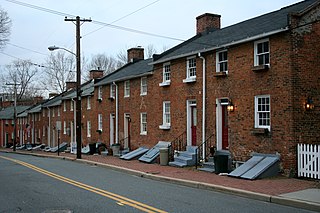
Oella is a mill town on the Patapsco River in western Baltimore County, Maryland, United States, located between Catonsville and Ellicott City. It is a 19th-century village of millworkers' homes.

Darlington is an unincorporated community and census-designated place in northeastern Harford County, Maryland, United States. The population was 409 at the 2010 census. The center of the community was listed on the National Register of Historic Places as the Darlington Historic District in 1987. Median household income is $66,563. The percentage of people in poverty is 5.3%.

A Friends meeting house is a meeting house of the Religious Society of Friends (Quakers), where meeting for worship is usually held. Typically Friends meeting houses do not have steeples.
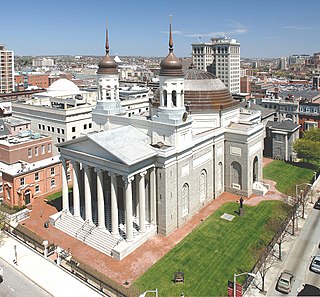
The Cathedral Hill Historic District is an area in Baltimore, Maryland. It lies in the northern part of Downtown just south of Mount Vernon. Roughly bounded by Saratoga Street, Park Avenue, Hamilton Street, and St. Paul Street, these 10 or so blocks contain some of the most significant buildings in Baltimore. The area takes its name from the Basilica of the Assumption which sits in the heart of the district. Despite the number of large religious structures in the area, the district's buildings are primarily commercial in character, with a broad collection of significant commercial structures ranging in date from 1790 to 1940.

The Sandy Spring Friends Meetinghouse is a historic building located at Sandy Spring, Montgomery County, Maryland. It is a large, Flemish bond brick, Federal-style Quaker Meeting House built in 1817. The meetinghouse is on two acres deeded by James Brooke in the 1750s, for the use of the Quaker Meeting. Nearby is the cemetery where he and many of his descendants were buried.
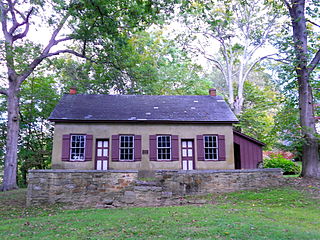
The Colora Meetinghouse is a historic Friends meeting house located at Colora, Cecil County, Maryland, United States.

East Nottingham Meetinghouse, or Brick Meetinghouse, is a historic Friends meeting house located at Rising Sun, Cecil County, Maryland. It consists of three different sections: the Flemish bond brick section is the oldest, having been built in 1724, 30 feet 3 inches (9.22 m) by 40 feet 2 inches (12.24 m); the stone addition containing two one-story meeting rooms on the ground floor, each with a corner fireplace at the south corners of the building, and a large youth gallery on the second floor; and in the mid 19th century, a one-story gable roofed structure was added at the southwest corner of the stone section to serve as a women's cloakroom and privy. It is of significance because of its association with William Penn who granted the site "for a Meeting House and Burial Yard, Forever" near the center of the 18,000-acre (73 km2) Nottingham Lots settlement and was at one time the largest Friends meeting house south of Philadelphia. The Philadelphia Half-Yearly Meeting was held here as early as 1725. During the Revolutionary War, an American Army hospital was established here in 1778 for sick and wounded troops under General William Smallwood's command and the Marquis de Lafayette's troops camped in the Meeting House woods on the first night of their march from the Head of Elk to victory at the Battle of Yorktown in 1781.

The West Nottingham Meetinghouse, or Little Brick Meetinghouse, is a historic Friends meeting house located at Rising Sun, Cecil County, Maryland, United States. It is a brick one-story building built in 1811, rectangularly shaped, and measuring 45 feet, 4 inches by 30 feet. Also on the property is a graveyard. The structure features two entrances, one for women and one for men, and sliding panels to divide the interior space in half, as well as the raised "Elder's Benches."

Deer Creek Friends Meetinghouse is a historic Friends meeting house located at Darlington, Harford County, Maryland. It is a one-story fieldstone structure, six bays long on the south, four bays on the north, and three bays wide. It was constructed in 1784 to replace a building of 1737 and renovated in 1888. The interior is divided into two spaces by an original paneled partition and the benches are original, with 10 benches in each room and an aisle down the center. The property also includes a five-stall horse shed and a cemetery with burials dating from 1775 to 1930.

The Little Falls Meetinghouse is a historic Friends meeting house located at Fallston, Harford County, Maryland, United States. It was constructed in 1843 and is a sprawling one-story fieldstone structure with shallow-pitched gable roof and a shed-roofed porch. The building replaced an earlier meetinghouse built in 1773. Also on the property is a cemetery and a one-story frame mid-19th century school building, with additions made post-1898 and in 1975. It features the characteristic two entrance doors and a sliding partition dividing the interior into the men's and women's sides. The Friends currently meet on the former men's side of the meetinghouse, and the women's side is only used for large groups and special occasions.

Pipe Creek Friends Meetinghouse is a historic Friends meeting house located at Union Bridge, Carroll County, Maryland, United States. It is a 1+1⁄2-story brick structure in Flemish bond on a stone foundation. The meetinghouse was begun in 1771 and completed the next year. A fire in October 1934 destroyed the interior, but the original benches were saved. The founders of the meetinghouse were immigrants from the north of Ireland. It was the Quaker meetinghouse attended by a great-grandfather of President Herbert Hoover.
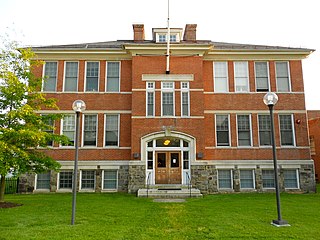
Howard Park P.S. 218, also known as School 7, is a historic elementary school located at Baltimore, Maryland, United States. It is an early 20th-century brick school building located in the intact historic west Baltimore neighborhood of Howard Park. The earliest school building was constructed in 1908 and enlarged in 1913, 1936, and in 1957. The older sections are built of brick and accented with limestone details. It continued to function as a school until 1980.
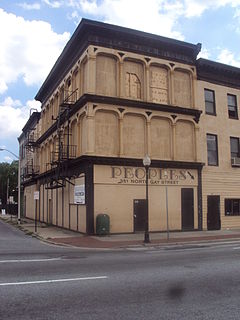
Old Town Savings Bank, also known as Cala Brothers, is a historic loft building located at Baltimore, Maryland, United States. It is a three-story loft structure designed by architect Frank E. Davis (1839-1921) and constructed in 1871. Both the street façades are cast iron, four bays wide on Gay Street and eight bays wide on Exeter Street. It is a Full Cast Iron Front building. It operated as a bank until about 1940, then housed a wholesale distributor of tobacco and confectionery.

Eastern Female High School, also known as Public School No. 116, is a historic female high school located on the southeast corner of the 200 block of North Aisquith Street and Orleans Street, in the old Jonestown / Old Town neighborhoods, east of Downtown Baltimore and now adjacent to the recently redeveloped Pleasant View Gardens housing project / neighborhood of Baltimore, Maryland, United States. It was built in 1869-1870 and is typical of the Italian Villa mode of late 19th-century architecture. It was dedicated in a large ceremony with speeches later published in a printed phamplet and attending crowds in early 1870. Old Eastern High is a two-story brick structure that features a square plan, three corner towers, and elaborate bracketing cornices, with a similar wood decorated porch/portico over front entrance on its west side facing Aisquith Street.

Stone Hill Historic District is a national historic district in Baltimore, Maryland, United States. It is one of the original mill villages along the Jones Falls, having been developed circa 1845–1847 to house textile mill workers. Comprising seven blocks, the district includes 21 granite duplexes, a granite Superintendent's House, and a granite service building – all owned by Mount Vernon Mills from 1845 to 1925.

Oakenshawe Historic District is a national historic district in Baltimore, Maryland, United States. It comprises 334 buildings which reflect the neighborhood's development during the period 1890 to about 1926. The neighborhood evolved in two stages on the 19th century Wilson estate. The first phase of growth is represented by frame houses dating from 1890 to about 1910 reflecting vernacular interpretations of the Victorian Gothic and Italianate styles. The second stage of development began in the World War I era, when several developers transformed the property by constructing a neighborhood of brick "daylight" rowhouses in revival styles popular at the time.
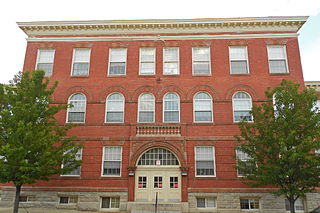
Franklin Square Historic District is a national historic district in Baltimore, Maryland, United States. It is a 19th-century rowhouse neighborhood developed along a strict grid street pattern. A one square block, two and a half acre public park, Franklin Square, is a focal point for the area and the most elaborate rowhousing surrounds the square. The district contains approximately 1,300 buildings of which approximately 1,250 contribute to the significance of the historic district.

Franklintown Historic District is a national historic district in Baltimore, Maryland, United States. It is the result of a plan developed in 1832 by William H. Freeman (1790–1863), a local politician and entrepreneur. His plan evolved gradually over the course of several decades and owes its success to his untiring promotion of the village. The central feature is an oval plan with radiating lots around a central wooded park. The district includes an old stone grist mill known as Franklin Mill, the innovative radiating oval plan, and the associated hotel and commercial area. The key residential buildings are excellent examples of the "I"-house form and display steeply pitched cross gables found in vernacular rural buildings throughout much of Maryland.

Birmingham Friends Meetinghouse is a historic Quaker meeting house at 1245 Birmingham Road in Birmingham Township, Chester County, Pennsylvania. The current meetinghouse was built in 1763. The building and the adjacent cemetery were near the center of fighting on the afternoon of September 11, 1777 at the Battle of Brandywine. Worship services are held weekly at 10am. The meetinghouse and adjacent octagonal schoolhouse were listed on the National Register of Historic Places as Birmingham Friends Meetinghouse and School on July 27, 1971.

Old Kennett Meetinghouse is a historic meeting house of the Religious Society of Friends or "Quakers" in Kennett Township near Chadds Ford, Pennsylvania.























